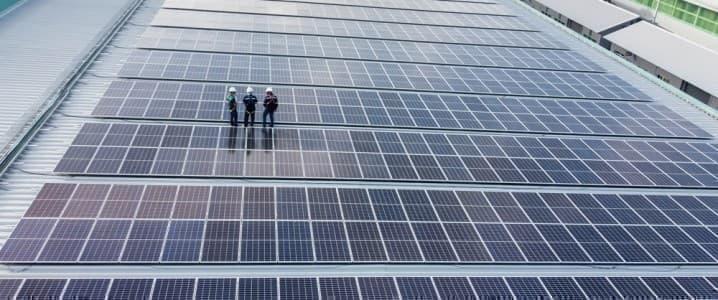An increasing number of investments have been made in a wide range of clean energy projects since the introduction of the Inflation Reduction Act (IRA) by U.S. President Biden in the summer of 2022. The reform appears to have set in motion a renewable energy boom that many other parts of the world hope to follow. One area of development that has been accelerated by the IRA and other related policies is clean energy manufacturing, with Biden encouraging greater national production of energy components to create jobs and reduce the reliance on foreign powers for new renewable energy capacity.
By October 2022, the IRA had spurred at least $28 billion in green energy manufacturing investments. President Biden introduced the IRA both to reduce national inflation and to support a green transition through the rapid development of the U.S. renewable energy industry. The IRA provides almost $400 billion in federal funding to the clean energy sector. Although there was no promise that the reform could attract higher levels of private funding to the industry, it outlines favourable policies for companies looking to invest in clean energy and decarbonisation projects, which seems to have caught the eyes of investors.
Much of the initial green manufacturing funding was earmarked for the electric vehicle (EV), battery, and solar manufacturing sectors, however, we can expect to see a more diverse range of investments as more companies take advantage of the public funding opportunities, subsidies, and tax breaks. The legislation is expected to attract as much as $1.7 trillion in new investment within the next decade, according to Credit Suisse. This could help to create up to 9 million new jobs over the same period, as well as increase the U.S. GDP by around 1 percent.
New green manufacturing activities have also been encouraged by President Biden’s Made in America strategy. During his first week in office, Biden signed Executive Order 14005, launching a government-wide initiative to strengthen the use of federal procurement to support American manufacturing. The order also allowed for the establishment of the Made in America office within the White House Office of Management and Budget.
In the EV manufacturing sector, nearly all U.S. automakers have announced plans for operational expansion. Previously, there was uncertainty around the future of the federal EV tax credit, which may have dissuaded consumers from investing in EVs, but the IRA extends this tax credit for a decade, as well as lifts the manufacturer cap of 200,000 vehicles. Last year, GM announced plans to invest $760 million in its existing Toledo Propulsion Systems plant to expand manufacturing, as well as $491 million at an existing Indiana stamping plant, to produce EV components.
Foreign EV manufacturers have also shown an interest in the U.S. market since the introduction of the IRA, including the South Korean automaker Kia, which will begin production in the U.S. starting in 2024. By moving manufacturing operations to the U.S., foreign companies can qualify for IRA incentives for which they wouldn’t otherwise be eligible.
There has also been a surge in interest in battery manufacturing. In September 2022, Ford commenced construction on its multibillion-dollar advanced manufacturing complex for lithium-ion batteries in western Tennessee. Meanwhile, GM and South Korean battery maker LG Energy Solution Ltd. obtained a $2.5 billion loan from the U.S. Department of Energy (DoE) for their Ultium Cells LLC venture. They expect to invest a minimum of $7.2 billion in lithium-ion battery cell facilities in Michigan, Ohio, and Tennessee. The anticipated growth in the U.S. battery manufacturing market could see U.S. lithium-ion cell production increase tenfold between 2021 and 2025, to 382 GWh. This would give the U.S. a projected 14 percent share of global battery cell production capacity, with Georgia, Kentucky, and Michigan expected to dominate the country’s EV battery manufacturing market.
As well as EV and battery production, we are seeing greater interest in renewable energy component manufacturing. In July, First Solar, the biggest U.S. solar panel producer, announced plans to build its fifth U.S. factory supported by financial incentives from the IRA. It is expected to invest around $1.1. billion in the new facility and increase its manufacturing capacity by 3.5 GW. The company has already invested $2.8 billion over the last year to increase production, with a new site in Alabama and an expansion to its Ohio site. First Solar has been unable to meet the soaring demand for solar panels, having sold out until 2026.
Recent political initiatives, such as Made in America and the IRA, have spurred both public and private investment in the clean energy manufacturing sector, with significantly more expected to follow over the next decade. The IRA is thought to have attracted over $150 billion in capital investments since it was passed, many of which are in manufacturing. This will see the U.S. become highly competitive in the manufacturing of EVs, lithium-ion batteries, and green energy components, helping to ensure the resilience of its supply chain for future projects and therefore solidify its energy security.
By Felicity Bradstock for Oilprice.com
More Top Reads From Oilprice.com:
- UK Carbon Prices Tumble, Casting Shadows On Decarbonization Efforts
- Distillate Prices Soar On The Back Of Refinery Issues And Expensive Crude
- Germany At Risk Of Natural Gas Shortages For Years To Come


















